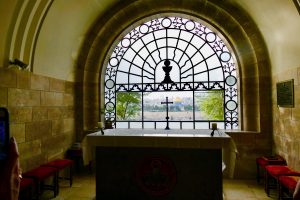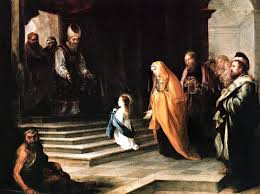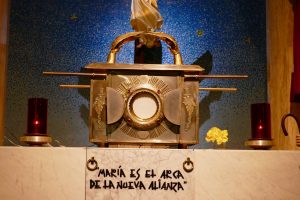HOMILY WEEK 33 04 – Year I (Homily 02)
Faith as Courage, Fidelity and Surrender:
Memorial of the Presentation of Mary
(1 Macc 2:15-29; Ps 50; Lk 19:41-44)
**********************************************
 Nicky Gumble, in the Alpha Program, recounts the possibly true story of a young man in the Thirties who asked his friends if they believed he could push a wheelbarrow on a high wire over Niagara Falls. They replied of course not – no one could do that. He told them to watch, a line was rigged up and he pushed a wheelbarrow over the falls and back. Then he asked his friends if they now believed he could do that, to which they replied, Yes, they did – they had just seen him do it. He asked again if they really believed he could do that, and they affirmed again they did. Then he said, “Okay, if you really believe, who’ll be the first? Get in and I’ll give you a ride!”
Nicky Gumble, in the Alpha Program, recounts the possibly true story of a young man in the Thirties who asked his friends if they believed he could push a wheelbarrow on a high wire over Niagara Falls. They replied of course not – no one could do that. He told them to watch, a line was rigged up and he pushed a wheelbarrow over the falls and back. Then he asked his friends if they now believed he could do that, to which they replied, Yes, they did – they had just seen him do it. He asked again if they really believed he could do that, and they affirmed again they did. Then he said, “Okay, if you really believe, who’ll be the first? Get in and I’ll give you a ride!”
Today’s readings and the memorial of the Presentation of Mary invite us into a stronger faith in Jesus expressing itself as courage, fidelity and surrender.
All of us can readily grasp the difference between believing someone can push a wheelbarrow over Niagara Falls, and actually getting into the wheelbarrow, a much deeper act of trust and surrender. Apparently, the only person who took this young man up on his offer was his mother!
We, however, are being invited to not just believe in God, but to also have faith, trust, surrender our will and get into God’s wheelbarrow. Step Three of the 12 Step program puts it succinctly: “Made a decision to surrender our lives and our wills to the care of God as we understood God.”
The passages from the Book of Maccabee’s we have listened to the last few days offer us rather radical examples of exactly that – a raw faith in God’s love and law that allowed first Eleazar at the age of ninety, then a mother and her seven sons to courageously lay their lives on the line and accept a martyr’s death. Today we hear of Mattathias who out of zeal for the law, actually breaks the law not to kill, and then heads for the hills as a fugitive and freedom fighter, along with others who long for “righteousness and justice.”
In the gospel, Jesus weeps over Jerusalem, for straying away from the intimate covenant relationship God always wanted with them, into a blind over-attachment to the false gods of possessions, prestige, power and pleasure exemplified especially by collusion with the Roman occupiers and total, blind enmeshment with a rote, dutiful, pietistic sacrificial system of temple-worship that fulfilled regulations but had lost any power to change hearts and transform lives. Ultimately, they were so caught up in that empty ritualistic system and blinded by the ornate beauty of the temple that they were unable to recognize the true law of love incarnate in Jesus of Nazareth, and rejected him outright.

View of Jerusalem from the Dominus Flevit Church
The Dominus Flevit Church overlooking Jerusalem commemorates where Jesus laments over Jerusalem because it failed to acknowledge him. He said, “They will smash you to the ground and your children within you, and they will not leave one stone upon another within you because you did not recognize the time of your visitation.” This is a thunderclap, a shock, a highly subversive thing to say. It would be something like a president-elect coming upon the White House in the midst of a crowd of his supporters and saying, “All of this will be destroyed.”
But this is precisely what Jesus does here, reminding us nothing in this world lasts, which is actually the heart of the Gospel. Nothing in this world should, therefore, be the object of our deepest longings or of our most powerful commitments, including those secondary goods of possession, prestige, power and pleasure.
The temple represented all of the glitter and glamor of this world, the best it can offer; and the people standing there, entranced by it, stand for all of us down through the ages who stand staring up at the goods of this world. So, we must free ourselves from worldly attachments and live for God alone.
Today’s memorial offers us an even greater example of this than from the Book of Maccabees, of one whose faith allowed her to not just believe in her Son as the Messiah, but also allowed her to make her “Fiat,” her leap of faith, and accept to be the mother of God’s own Son. She would be the first and perfect disciple, surrendering herself completely to God’s will, pondering the mystery living within her she did not understand, caring for him with a mother’s love, believing in Jesus as Emmanuel (God among us), telling the servants at Cana, and us, to “Do what he tells you,” doing at the foot of the Cross what Jesus was doing on the Cross – forgiving those who were crucifying him, accepting to be our spiritual Mother, and we believe, is now in glory with the Father and Jesus, interceding for us.
 This memorial of the Presentation of Mary in the Temple originated as a commemoration of the dedication of the Basilica of St. Mary the New in Jerusalem in 543. An apocryphal account recounts that Mary’s parents, Joachim and Anna, brought Mary as a three-year old child to the Temple in Jerusalem to offer her to God, as was the custom. Inspired by a priest’s vision, they left her there to praise and serve God. The much later presentation of Jesus in the Temple serves as a background: while the offering of the poor, two turtle doves, were offered, really no offering was needed as Jesus was himself the Temple. This memorial spread to the Western Church in 1585, and honors Mary as a temple where God lives, so for her as well, no offering was necessary.
This memorial of the Presentation of Mary in the Temple originated as a commemoration of the dedication of the Basilica of St. Mary the New in Jerusalem in 543. An apocryphal account recounts that Mary’s parents, Joachim and Anna, brought Mary as a three-year old child to the Temple in Jerusalem to offer her to God, as was the custom. Inspired by a priest’s vision, they left her there to praise and serve God. The much later presentation of Jesus in the Temple serves as a background: while the offering of the poor, two turtle doves, were offered, really no offering was needed as Jesus was himself the Temple. This memorial spread to the Western Church in 1585, and honors Mary as a temple where God lives, so for her as well, no offering was necessary.
 There is a tabernacle in the Blessed Sacrament Chapel in the Oblate Parish of Our Lady of Guadalupita in Mexico City that captures the reality of Mary as a Temple in which Jesus abides. At the Annunciation, through her Fiat, she became the Ark of the New Covenant, in which the Word of God dwelt. Her Visitation to her cousin was actually the first Eucharistic procession, journeying with her unborn child Jesus. The unseen presence of Jesus in Mary’s womb caused his cousin John the Baptist to leap with joy in the womb of his mother Elizabeth, who also cried out with joy at the wonder of Mary being the mother of our Lord! We are reminded that we also are meant to be temples where the Lord lives, offering our lives to the Lord.
There is a tabernacle in the Blessed Sacrament Chapel in the Oblate Parish of Our Lady of Guadalupita in Mexico City that captures the reality of Mary as a Temple in which Jesus abides. At the Annunciation, through her Fiat, she became the Ark of the New Covenant, in which the Word of God dwelt. Her Visitation to her cousin was actually the first Eucharistic procession, journeying with her unborn child Jesus. The unseen presence of Jesus in Mary’s womb caused his cousin John the Baptist to leap with joy in the womb of his mother Elizabeth, who also cried out with joy at the wonder of Mary being the mother of our Lord! We are reminded that we also are meant to be temples where the Lord lives, offering our lives to the Lord.
The Eucharist is a celebration today of the Word made flesh within Mary’s womb, and the unconditional love of God lived out by Jesus on the cross. May our celebration strengthen our faith in Jesus, and empower us to courageously express that faith through fidelity and surrender.




Well thanks for the lovely homilies and messages about Mary and asking us to surrender ourselves to the Lord. If we believe and trust in Jesus Christ then we are to surrender ourselves to him. He is the one who can lead us to have forgiveness and healing if we want to be reconciled and repent for all sins and wrongdoings that is bottled up inside us. If we want to change we must turn towards God by asking him to forgive us and heal us fully . We have to say those words that comes from our hearts and we really meant it ; this is the part of the healing process. It is only God or Jesus Christ who can save us and lead us closer to the Kingdom of heaven. We are to express our faith through fidelity and surrender to God’s will . Amen. Thanks be to God
Thanks Bishop Sylvain Lavoie for all beautiful homilies and reflections . May God Bless you . ??????❤️❤️